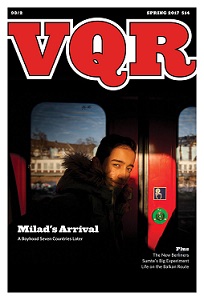This cerebral magazine is both microscope and telescope

Let’s start with the Jedi.
When you open the Winter 2017 issue of the Virginia Quarterly Review, the first feature article is an interview with Alex Bird, a knight and deacon in the Temple of the Jedi Order. (Yes, those Jedi.)
But the surprise of reading about a real-life Star Wars religion is quickly eclipsed by the surprise of something even more pleasurable — an encounter with a thoughtful man who recognizes both the artifice and the grace of his chosen “myth.”
“All myths are true. Not literally true; they’re truths about us, they’re stories about us, they’re always stories about people,” he says.
Stories that might not be literally true yet evoke a deeper truth fill the pages of VQR. “The spirit of the magazine targets the passionate generalist,” editor Paul Reyes says. “This publication should have something for everyone, whether people are interested in dogged in-depth journalism, fiction, poetry, or documentary photography.”
Add to that personal essay, criticism, and art, and you start to get a feel for the breadth of the material between VQR’s glossy covers.
On the cover of the Spring 2017 issue, the guarded but optimistic eyes of a handsome young boy stare at us from inside what looks to be a subway car. His name is Milad, and he is a 14-year-old Afghan boy living in Germany, awaiting a decision on his family’s refugee status while trying to stitch together a life for himself.
Photographer Diana Markosian gave Milad a Polaroid camera to allow him to document his new world in Germany, and his mixed-media creations whisper about the ache of an adolescence pressed into the shape of bland food and empty schoolyards. Markosian’s accompanying photographs are eloquent in a different way, offering us the details of Milad’s transplanted life.
Haunting photographs take on a deeper meaning in the Winter 2017 issue, where writer Leslie Jamison invites us into the portraits photographer Annie Appel took of one extended Mexican family over more than 20 years. “If Annie wanted a close-up, she had to get close,” Jamison writes in her thoughtful essay.
Getting closer might be VQR’s mission, in a way, if getting closer to our human truths can be understood as searching for them from every angle. In the beginning of this century, VQR’s editorial leadership “broke apart the shell of the literary journal to make it something more colorful, dynamic, and unexpected,” Reyes says. “What we have done since is try and pursue the ways in which this magazine, the experience, can be much bigger than its trim size.”
The internet, naturally, helps expand VQR beyond its bindings (a short story by Stephen King is a popular favorite), as does its annual writers’ conference in Charlottesville (this year’s is July 10-15). But on flat paper alone, this heartfelt magazine is both microscope and telescope, looking down into our depths and up into our heavens.
Or, as poet Kaveh Akbar writes in his poem in the Spring 2017 issue, “I’m done trying to make sense / of any of this / no one will believe anything / that comes out of a mouth like mine.”
And that’s truth enough.
Carrie Callaghan is a senior editor with the Washington Independent Review of Books. Her fiction has appeared in Silk Road, Floodwall, the MacGuffin, the Mulberry Fork Review, and elsewhere. She lives in Maryland with her family and two cats. Find her on the Internet on Twitter at @carriecallaghan or at www.carriecallaghan.com.

